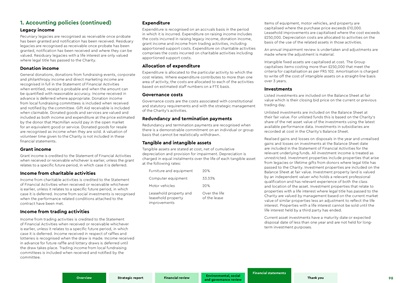
1. Accounting policies (continued)
Legacy income
Pecuniary legacies are recognised as receivable once probate
has been granted and notification has been received. Residuary
legacies are recognised as receivable once probate has been
granted, notification has been received and where they can be
valued. Residuary legacies with a life interest are only valued
where legal title has passed to the Charity.
Donation income
General donations, donations from fundraising events, corporate
and philanthropy income and direct marketing income are
recognised in full in the Statement of Financial Activities
when entitled, receipt is probable and when the amount can
be quantified with reasonable accuracy. Income received in
advance is deferred where appropriate. Donation income
from local fundraising committees is included when received
and notified by the committee. Gift Aid receivable is included
when claimable. Donated goods and services are valued and
included as both income and expenditure at the price estimated
by the donor that Macmillan would pay in the open market
for an equivalent good or service. Donated goods for resale
are recognised as income when they are sold. A valuation of
volunteer time given to the Charity is not included in these
financial statements.
Grant income
Grant income is credited to the Statement of Financial Activities
when received or receivable whichever is earlier, unless the grant
relates to a specific future period, in which case it is deferred.
Income from charitable activities
Income from charitable activities is credited to the Statement
of Financial Activities when received or receivable whichever
is earlier, unless it relates to a specific future period, in which
case it is deferred. Income from social investments is recognised
when the performance related conditions attached to the
contract have been met.
Income from trading activities
Income from trading activities is credited to the Statement
of Financial Activities when received or receivable whichever
is earlier, unless it relates to a specific future period, in which
case it is deferred. Income received in respect of raffles and
lotteries is recognised when the draw is made. Income received
in advance for future raffle and lottery draws is deferred until
the draw takes place. Trading income from local fundraising
committees is included when received and notified by the
committee.
Expenditure
Expenditure is recognised on an accruals basis in the period
in which it is incurred. Expenditure on raising income includes
the costs incurred in raising legacy income, donation income,
grant income and income from trading activities, including
apportioned support costs. Expenditure on charitable activities
comprises the costs incurred on charitable activities including
apportioned support costs.
Allocation of expenditure
Expenditure is allocated to the particular activity to which the
cost relates. Where expenditure contributes to more than one
area of activity, the costs are allocated to each of the activities
based on estimated staff numbers on a FTE basis.
Governance costs
Governance costs are the costs associated with constitutional
and statutory requirements and with the strategic management
of the Charity's activities.
Redundancy and termination payments
Redundancy and termination payments are recognised when
there is a demonstrable commitment on an individual or group
basis that cannot be realistically withdrawn.
Tangible and intangible assets
Tangible assets are stated at cost, net of cumulative
depreciation and provision for impairment. Depreciation is
charged in equal instalments over the life of each tangible asset
at the following rates:
Furniture and equipment 20%
Computer equipment 33.33%
Motor vehicles 20%
Leasehold property and Over the life
leasehold property of the lease
improvements
Items of equipment, motor vehicles, and property are
capitalised where the purchase price exceeds £10,000.
Leasehold improvements are capitalised where the cost exceeds
£250,000. Depreciation costs are allocated to activities on the
basis of the use of the related assets in those activities.
An annual impairment review is undertaken and adjustments are
made where the adjustment is material.
Intangible fixed assets are capitalised at cost. The Group
capitalises items costing more than £250,000 that meet the
criteria for capitalisation as per FRS 102. Amortisation is charged
to write off the cost of intangible assets on a straight-line basis
over 3 years.
Investments
Listed investments are included on the Balance Sheet at fair
value which is their closing bid price on the current or previous
trading day.
Unlisted investments are included on the Balance Sheet at
their fair value. For unlisted funds this is based on the Charity's
share of the net asset value of the investments using the latest
available performance data. Investments in subsidiaries are
recorded at cost in the Charity's Balance Sheet.
Realised gains and losses on disposals in the year and unrealised
gains and losses on investments at the Balance Sheet date
are included in the Statement of Financial Activities for the
relevant underlying funds. All investment income is treated as
unrestricted. Investment properties include properties that arise
from legacies or lifetime gifts from donors where legal title has
passed to the Charity. Investment properties are included on the
Balance Sheet at fair value. Investment property land is valued
by an independent valuer who holds a relevant professional
qualification and has relevant experience of both the class
and location of the asset. Investment properties that relate to
properties with a life interest where legal title has passed to the
Charity are valued by management based on the current market
value of similar properties less an adjustment to reflect the life
interest. Properties with a life interest cannot be sold until the
life interest held by a third party has ended.
Current asset investments have a maturity date or expected
disposal date of less than one year and are not held for longterm
investment purposes.
98
Environmental, social
and governance review
Financial review
Strategic report
Overview
Financial statements
Thank you